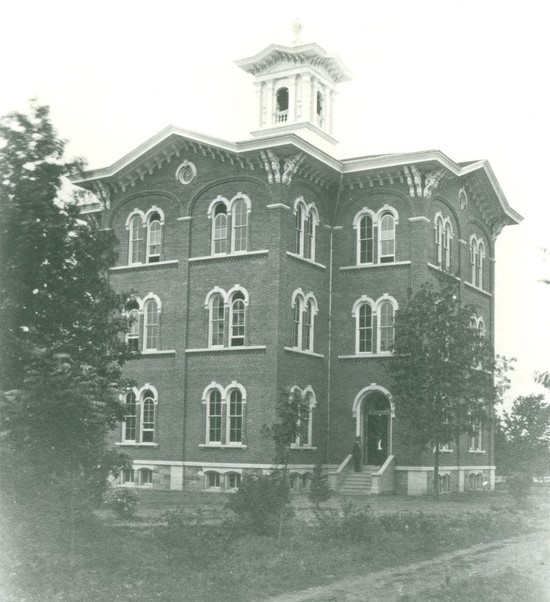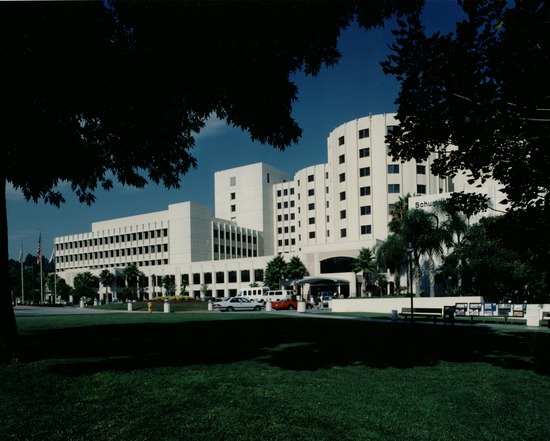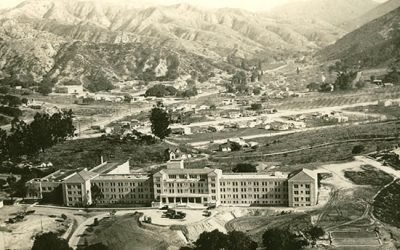On the outside, Seventh-day Adventist universities may not look much different than other college campuses. But the real differences are beneath the surface.
Adventist Universities are all about helping each student have a fulfilling educational journey on a Christ-centered campus. Lifelong friendships are forged. Pivotal career decisions are made. And the supportive spiritual environment can help students grow in immeasurable ways.
Let’s take a closer look at what makes Adventist universities so loved by both their alumni and their surrounding communities.
- The story of the Adventist college
- What is the mission of Adventist universities?
- Why would someone choose an Adventist university?
- Adventist universities in North America
We’ll start with some history.
The story of the Adventist college

Battle Creek College, Battle Creek, Michigan
The first Adventist college was born in 1874 with Michigan’s Battle Creek College (present-day Andrews University). The Adventist Church was exceptionally committed to quality education, especially coming out of a time when the United States was more industrially focused than scholastically focused.
These campuses also provided a place to formally train pastors and teachers, as well as other professions that were in high demand for mission service.
A few years later, Pacific Union College’s forefather, Healdsburg College, opened in 1882.
This was closely followed by the Battle Creek College Training School for Nurses within the Battle Creek Sanitarium, which spurred the development of Adventist nursing schools, hospitals, and eventually, medical schools.
In 1895, the Sanitarium began the first Adventist medical school, American Medical Missionary College.
In 1893, Claremont Union College in South Africa became the first Adventist college outside the United States. Soon after, Adventist universities opened in Australia, South America, and Europe, respectively.
Today, Adventist universities have blossomed everywhere. There are currently 117 Adventist colleges dotting the globe,1 forming the second largest Christian school network in the world.2
What is the mission of Adventist universities?
Originally, Adventist education began with the purpose of training denominational workers and providing children with a higher quality education than was typically available at the time.3
Today, the goal isn’t much different: Adventist universities equip students with the necessary skills for today’s workforce, while also teaching them how their faith can be woven into everything they aspire to do.
Adventists believe that education is key when it comes to being good stewards of our minds and our talents. This echoes the Bible’s emphasis that pursuing knowledge and getting to know God goes hand in hand (Proverbs 9:10).
With this in mind, Adventist colleges operated with an emphasis on each student being a unique individual with God-given gifts.4 Students were to be encouraged to use the abilities God gave them, so they can become cheerful contributors to their communities.
That’s why Adventist universities provide a well-rounded education to promote spiritual, mental, physical, and social health, intellectual growth, and service.5
Along with serving, Adventist universities promote excellence, intelligence, engagement, and community. All these support the umbrella of faith, to best equip students to relay the gospel to the world.6
And if anyone is considering a career in health care, an Adventist university can be a terrific fit due to the special emphasis Adventists place on the need for caring, quality medical care.
Let’s take a look at some of the specific reasons people choose Adventist colleges.
Why would someone choose an Adventist university?

Photo by Ivan Samkov
A number of things set Adventist universities and colleges apart.
- Variety of quality programs: Adventist universities offer competitive programs in a wide range of majors. For example, Southern Adventist University is known for its nursing program, which is in the top 20% in the United States.7 La Sierra University’s Enactus business team has won two Enactus world cups.8 And Loma Linda University is considered one of the best medical schools in the U.S.9
- Competitive graduation rates: Most Adventist universities have a graduation rate at or above the national average of 55%. Andrews University, for example, hands diplomas to 61% of its undergraduates.10 Loma Linda University graduates 87% of its students.11 Most of the other Adventist campuses range from 50%-59%.
-
Diversity: Attracting students from all over the world causes Adventist campuses to be diverse places, which can enrich the educational experience. As of 2018, Andrews University ranked #1 in campus ethnic diversity. That year, 20% of their students came from other countries.12 In 2021, La Sierra University took the same prize.13 Adventists are not the only students who attend, either. So many students from other faiths and philosophies want to attend that in some cases, they almost double the enrollment.14
- Close-knit campuses: Adventist colleges tend to have a smaller student body. Their U.S. schools range from 754 students (Southwestern Adventist University) to 4,514 (Loma Linda University). Compare this to the numbers of all other American universities, which are as high as 63,124.15 Students at large universities can feel like just a number, while smaller universities help students feel like a meaningful part of the community.
- Smaller student-faculty ratio: Smaller classes also mean more one-on-one attention from the professors. The average student faculty ratio in North American Adventist colleges is 11:1, with the national average at 14:1.16 In these close-knit environments, students can build strong, lasting relationships.
- Biblical emphasis: Throughout all parts of the college experience, students learn how the Bible can be part of everything. This is even woven into the class structure. For example, Southern Adventist University asks professors to create a biblical course design model for each class they teach. This incorporates faith with the practical skills students learn.17 It’s also common for professors to offer prayer before class and sometimes share a Bible text or relevant devotional thought.
- Athletics: Some schools emphasize athletics more than others, but every school has some form of sports or activity options. Southern Adventist University students, for example, play only intramural sports. All competition is within Southern’s teams. Washington Adventist University, however, is more heavily involved in athletics. Their campus’ team, The Shock, is part of NAIA and USCAA and competes in basketball, cross country, volleyball, and soccer.18
How can I attend an Adventist university?
Attending an Adventist university is relatively easy. You don’t have to worry about a massive number of students also applying for the same program.
A quick search can tell you which Adventist university is closest to you, or you can look up several of them to see which ones have the programs you’re interested in. You can schedule a visit first, or you can dive right into the application process.
Yes, Adventist schools are private institutions and tend to have a heftier price tag. The average 2022 tuition and fees of Adventist universities in the United States is $25,707, with Kettering College the lowest at $14,23219 and Loma Linda the highest at $36,000.20 However, most schools offer scholarships to help ease the financial burden. Other financial aid is also available. Be sure to check out what each Adventist university offers.
Adventist universities in North America
In the North American Division, 13 universities and colleges serve their students.
- AdventHealth University: Situated in Orlando, Florida, AdventHealth trains students to become medical professionals in a wide range of areas.
- Andrews University: One of the most culturally diverse universities in the United States, Andrews attracts students to its campus in Berrien Springs, Michigan. It is particularly known for its theological seminary.
- Burman University: Canada’s “light on the hill” serves students from Lacombe, Alberta. It is best known for its program in education.
- Kettering College: Located in Kettering, Ohio, this is a place for students seeking medical degrees.
- La Sierra University: Located only 60 miles from Los Angeles, La Sierra has a prominent degree in criminal justice.
- Loma Linda University: Loma Linda is a large California university best known for its robust graduate medical programs.

Loma Linda University, Loma Linda, California
- Oakwood University: Historically founded to educate former slaves, Alabama’s Oakwood University is best known for its degrees in liberal arts and humanities.
- Pacific Union College: This college in Angwin, California, serves specifically undergraduates and is the largest source for Loma Linda University’s School of Medicine.
- Southern Adventist University: Based in Collegedale, Tennessee, Southern has an exceptional nursing program and other sciences.
- Southwestern Adventist University: Southwestern offers a unique degree in Fire Science. The university is located in Keene, Texas.
- Union College: Located in the heart of the great plains, this college is noted for its rescue program.
- Walla Walla University: Positioned near Walla Walla, Washington, this university boasts well-known engineering and nursing programs.
- Washington Adventist University: Located a stone’s throw from Washington, D.C., Washington has a strong nursing program and puts a high emphasis on athletics.
The church also operates a number of other universities around the world:
- Africa: 25
- Angola
- Botswana
- Cameroon
- Democratic Republic of Congo
- Ethiopia
- Ghana
- Kenya
- Liberia
- Madagascar
- Malawi
- Nigeria
- Rwanda
- South Africa
- Tanzania
- Uganda
- Zambia
- Zimbabwe
- Asia: 27
- Bangladesh
- China
- India
- Indonesia
- Japan
- Lebanon
- Malaysia
- Myanmar
- Pakistan
- South Korea
- Sri Lanka
- Taiwan
- Thailand
- Australia: 2
- Europe: 16
- Croatia
- Denmark
- Finland
- France
- Germany
- Hungary
- Italy
- Norway
- Poland
- Romania
- Russia
- Sweden
- Ukraine
- United Kingdom
- North and Central America: 29
- Belize
- Canada
- Costa Rica
- Cuba
- Dominican Republic
- Haiti
- Jamaica
- Mexico
- Puerto Rico
- Trinidad and Tobago
- United States of America
- Venezuela
- Pacific Ocean Islands: 15
- Fiji
- Papua New Guinea
- Philippines
- South America: 18
- Argentina
- Bolivia
- Brazil
- Chile
- Colombia
- Ecuador
- Peru
- Uruguay
Some of the most noteworthy universities around the world include:
- Adventist University of Africa: from Kenya, this institution was built to educate post-graduates in Africa. It offers theological, business, leadership, public health, and computer science degrees.
- Adventist University of France: Also called Campus Adventiste du Salève, this university is the only French-speaking Adventist institution in Europe.
- Adventist University of the Philippines: Based in Puting Kahoy, Silang, Cavite, Philippines, this school offers degrees ranging from the arts to medicine.
- Avondale University: Australia’s university in New South Wales offers a variety of programs and has a well-known nursing program.
- Newbold College: Situated in Binfield, Great Britain, students can earn a variety of religion, liberal arts, and business degrees. The school is part of Adventist Colleges Abroad.
- University of Montemorelos: One of five Adventist universities globally that grants degrees in medicine, this college in Nuevo León, Mexico, offers a large selection of programs.
Adventist universities are not only a place to earn a degree. They prepare the student for being a good citizen in their community and serving others. As Colossians 3:23-24 says, all of our work should be done well, as if for God. And this underlying principle fuels the pursuits of each Adventist higher learning institution.
- Adventist Universities.com, Adventist Universities, Accessed July 14, 2022, https://adventistuniversities.com/. [↵]
- “About Seventh-day Adventist Education,” Adventist Universities.com, Adventist Universities, Accesses July 14, 2022, https://adventistuniversities.com/adventist-education/. [↵]
- “The Birth of Adventist Education,” Lineage Journey.com, Present Lineage Journey, Accessed July 29, 2022, https://lineagejourney.com/read/the-birth-of-adventist-education/. [↵]
- Ibid. [↵]
- Ibid. [↵]
- Taylor, John Wesley V, “What is the Special Character of an Adventist College or University?”, Adventist.org, The Journal of Adventist Education, Accessed July 13, 2022, https://jae.adventist.org/2017.2.5. [↵]
- “Nursing Ranking 2022: Southern Adventist University,” Best Nursing Colleges.com, Best Nursing Colleges, Accessed July 14, 2022, https://best-nursing-colleges.com/southern-adventist-university. [↵]
- https://lasierra.edu/business/impact/ [↵]
- “Loma Linda University School of Medicine Ranking: How to Get Into?” MACThub.com, MCAT Hub, Accessed July 14, 2022, https://mcathub.com/loma-linda-university-school-of-medicine-ranking/. [↵]
- “Andrews University,” College Evaluator.com, College Evaluator, Accessed July 28, 2022, https://www.collegeevaluator.com/institute/andrews-university/. [↵]
- “Loma Linda University Graduation Rates and Retention Rates,” College Factual.com, College Factual, Accessed July 28, 2022. [↵]
- “Andrews University Ranked #1 for Ethnic Diversity,” Andrews.edu, Andrews Agenda, Accessed July 29, 2022, https://www.andrews.edu/agenda/47237/. [↵]
- Tucker, Darla Martin. “Wall Street Journal Again Ranks La Sierra No. 1 in Nation For Diversity,” La Sierra.edu, La Sierra University, Accessed July 29, 2022, https://lasierra.edu/article/wall-street-journal-again-ranks-la-sierra-no-1-in-nation-for-diversity/. [↵]
- Wright, Jard, “Recruiting Non-Adventist Students Already the Norm in Adventist Higher Education,” Spectrum Magazine.org, Spectrum Magazine, Accessed July 13, 2022, https://spectrummagazine.org/article/2017/04/26/recruiting-non-adventist-students-already-norm-adventist-higher-education. [↵]
- Wood, Sarah, “10 Colleges with the Most Undergraduate Students,” US News.com, USNews, Accessed July 29, 2022, https://www.usnews.com/education/best-colleges/the-short-list-college/articles/colleges-with-the-most-undergraduates. [↵]
- “US Colleges Student to Faculty Ratio Statistics,” Univstats.com, Univstats, Accessed July 29, 2022, https://www.univstats.com/corestats/student-faculty-ratio/. [↵]
- “Biblical Course Design Model,” Southern.edu, Southern Adventist University, Accessed July 29, 2022,https://www.southern.edu/administration/cte/BiblicalFoundations/BiblicalCourseDesignModel.html. [↵]
- “Washington Adventist University Athletics,” Adventist Colleges.com, Adventist Colleges and Universities, Accessed July 28, 2022, https://adventistcolleges.org/athletics/washington-adventist-university-athletics/. [↵]
- “Kettering College,” College Tuition Compare.com, College Tuition Compare, Accessed July 28, 2022, https://www.collegetuitioncompare.com/edu/203544/kettering-college. [↵]
- “Loma Linda University,” College Tuition Compare.com, College Tuition Compare, Accessed July 28, 2022, https://www.collegetuitioncompare.com/edu/117636/loma-linda-university. [↵]
Related Articles
More Answers
What Do Adventists Offer for Young Adults?
In recent years, the age group often classified as “young adults” has been trickier to engage. It’s been a significant concern for Christian churches around the world. Though interestingly enough, similar observations regarding young adults have been coming up in conversations about the economy, the entertainment industry, politics, and more.
King David: How Was He a Man After God’s Own Heart?
War, bloodshed, murder, adultery—all of these crimes overshadowed the life of a biblical Old Testament man named David. Yet he was called a man after God’s own heart, not to mention one of Israel’s greatest heroes and kings.
Do Seventh-day Adventists Believe in the Secret Rapture
The secret rapture belief asserts that the followers of Jesus will be suddenly and stealthily “raptured” from earth and taken to heaven. Then, any people left on earth will face a period of great difficulty—before Christ’s second coming actually happens.
Do I Need to be an Adventist to be Saved?
The answer to this question is simply, “no.”
When it comes to salvation in Jesus Christ, all that is required of a person is to acknowledge Jesus’ sacrifice for us, believe that He has saved us, and claim the free gift of salvation that is always available to us. Salvation is not based on denomination.
Do You Have to Be Vegetarian to Be Adventist?
Of course not. Membership in the Seventh-day Adventist Church has never included any dietary requirements. However, there might be some reasons people might think that. So many Adventists are vegetarians or even vegan, and a plant-based lifestyle has many health benefits.
What Does the Bible Say About the End Times?
First of all, when we say “end times,” this refers to the period of time that precedes the second coming of Jesus—and the end of this sinful world before it’s recreated into the new earth. And several passages of Scripture provide us with clues and guidelines to help us recognize when these times are near, what kinds of things we can expect, and what it might mean for our daily lives and priorities.
All About Seventh-day Adventist Colporteurs
The Seventh-day Adventist Church uses a variety of methods to spread the hope of the gospel to the world. One of these ways is through colporteuring, also called “canvassing” or “literature evangelism.”
How Ellen White Influenced the Adventist Health Message
Seventh-day Adventists are known for their emphasis on healthy living. And Ellen G. White was a significant influence in the development of this priority and practice among Adventists.
Does Prayer Work? If So, How Are Prayers Answered?
Prayer is how human beings reach out to a higher power. For Christians, it’s how we communicate with God. But does it really work? Is it true that God actually intervenes in situations when we call out to Him for help? And why are some prayers answered immediately, while others seem to go unanswered or not get answered for a long time?
What Did Ellen White Teach About Vegetarianism?
One thing you might have heard about Seventh-day Adventists is their emphasis on a vegetarian lifestyle. If you’re wondering why that is, it goes back to our church’s humble beginnings:
Steps to Christ: A Guide to a Relationship with Jesus
Whether you’re just starting your journey with Jesus Christ, are coming back after some time away, or have had a relationship with Jesus for years, using a book—in addition to the Bible—to guide or supplement that relationship can be helpful, comforting, and joyful.
What Is an Adventist Book Center (ABC)?
When you walk into any one of the many Adventist Book Center (ABC) locations, chances are you’ll be greeted by pleasant gospel music in the background, friendly employees, and row after row of Christian books, movies, Bibles, study guides, kids’ games, and more.
Prayer—How Do I Do It?
Prayer is intentional communication with God. And the way you go about it is much like how you’d communicate with your best friend. You can reach out anytime and anywhere, in the way that’s most natural between the two of you.
15 Examples of Prayer in the Bible
Prayer is the primary way we maintain our relationship with God. It’s our method of communication, and He miraculously hears every word that comes from our hearts.
Do Seventh-day Adventists Celebrate Holidays?
Wondering whether your Adventist classmate or coworker keeps the same holidays you do? Perhaps you want to include them in some festivities, but you also want to respect their beliefs. Thus, you’re unsure of how to navigate the holiday question. Will they accept your invitation to the office Christmas party?
Ellen White and Adventist Healthcare—Ahead of Their Time
Medical care in the mid-1800s was primitive, to say the least. Basic concepts we take for granted—such as proper handwashing or recognizing the dangers of bloodletting—were nonexistent. And doctors often had little more than nine months of training!
How Ellen White’s Teachings Can Improve Your Health
Healthcare in the nineteenth century was said to leave “more disease than it took away” with its use of bloodletting and “medicines” like mercury and arsenic. As people questioned these methods, new approaches popped up. But which ones were reliable?
Do Adventists Worship Ellen White?
Ellen White was a co-founder and leader in the Seventh-day Adventist Church from its beginning. Adventists believe that she had the prophetic gift (Ephesians 4:14; 1 Corinthians 12:28) and passes the biblical tests of a prophet.
Can I Be an Adventist If I Don’t Believe in Ellen White?
Ellen White is an important part of the Seventh-day Adventist Church: she played a significant role in its founding, provided biblical support for several key doctrines, and continues to inspire church members today with her insightful counsel.
The Adventist Haystack (It’s Not What You Think) + 4 Recipes
Haystacks are basically a taco salad—with an Adventist spin on it! Most versions are vegetarian and offer an endless combination of tasty toppings. We eat them often because they’re healthy, scrumptious, and easy to make.
Do Seventh-day Adventists Believe in Medical Care?
The Seventh-day Adventist Church believes in and supports evidence-based medical care. In fact, medicine has played a significant part in our history, and today we run a major health system with hospitals, medical schools, and clinics throughout the world.
Why do Adventists Emphasize Religious Liberty?
Adventists see religious liberty as an essential human right. After all, God endowed humanity with freedom of choice from the very beginning. So we believe it’s best for governments to also support their citizens’ rights to worship based on their convictions.
All about Adventist Elementary Schools
The Seventh-day Adventist Church operates the largest Protestant education system in the world. A big part of this system is our K-8 elementary schools, or primary schools, as they’re known in other parts of the world.
What Are Pathfinder and Adventurer Clubs?
Like the boy or girl scouts, Pathfinders and Adventurers learn about nature and life skills. But what makes these clubs special is their purpose to bring young people closer to Jesus.
13th Sabbath Offering: What It Is and Why It Matters
While the previous 12 Sabbaths of the quarter feature an established Adventist ministry and its current giving needs, the 13th is a rotating spot reserved for current mission projects.
What Is ASI (Adventist-Laymen’s Services and Industries)?
ASI, which stands for Adventist-laymen’s Services and Industries, is a membership-based organization that provides support for Seventh-day Adventist laypeople (Adventist professionals who aren’t pastors).
What Are Adventist Evangelistic Meetings?
The Seventh-day Adventist Church puts a huge emphasis on sharing the gospel through evangelism, or sharing the gospel through preaching, teaching, and testimony. One of the ways we accomplish this is by organizing public events called evangelistic meetings.
Rest and Reconnection: What It Really Means to Keep the Sabbath
The Bible tells us that we keep the Sabbath by avoiding work. God made this law because he knew it would strengthen us and bring us joy, as well as give us time to reconnect with Him and recharge from our busy lives.































